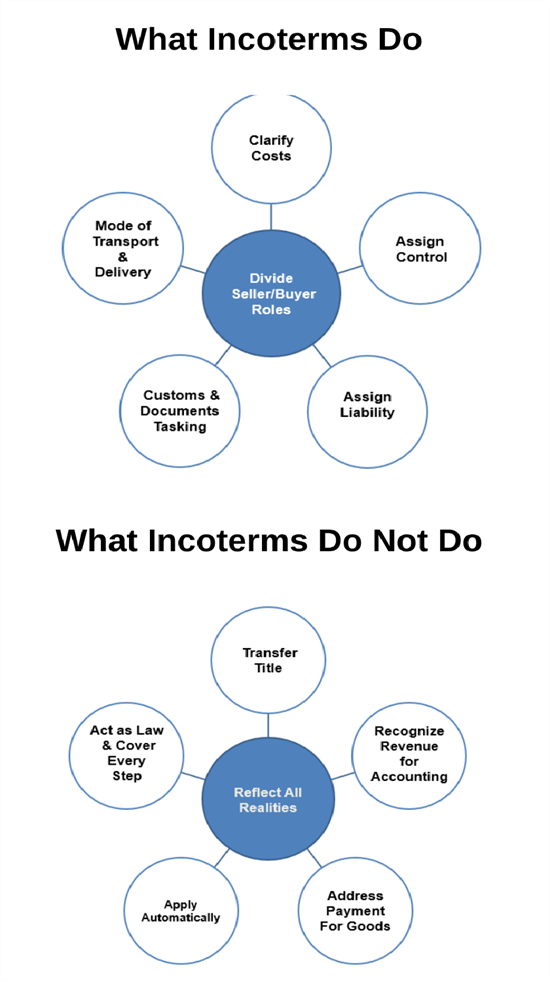Incoterms® 2020 has been released and went into affect on January 1st. Find out what changed, and learn how to make sure you are using Incoterms correctly in our latest blog.
With the recent release of Incoterms® 2020 we thought it would be helpful to our suppliers and buyers alike to review the basics of what Incoterms are, how they have changed in 2020, and how to use them properly.
Incoterms are a series of terms published by the International Chamber of Commerce that relate to international commercial law and are used in international commercial transactions while exporting and importing products.
You can learn more about the history of Incoterms on the Incoterms® rules history page on the ICC website to get a better understanding of the background and depth of the terms. Also check out the helpful infographic from the ICC below.
There are currently a total of 11 Incoterms in use, each starts with one of 4 letters, E, F, C, or D and describes a unique point in the international shipment process.
Group E – Departure
Group F – Main Carriage Unpaid
Any F term means the product has still not left the U.S. but has moved beyond the point of origin.
Group C – Main Carriage Paid
Port to port freight transaction.
Group D – Arrival
Once it has arrived at the port of import and been taken off the mode of transport (ship, plane, truck, train) it moves to Group D.

As any experienced exporter will know, nothing gets export or imported without a request for quotation; it has to move between an origin and a destination and that’s why trade terms are so important. Incoterms help to divide and clarify the cost, roles, and liabilities that both the buyer and sellers are agreeing to take on in an international agreement.
It is extremely important that those using Incoterms fully understand them and use them properly. Not all buyers/sellers will have the same level of understanding of Incoterms, so you might need to help the other party of your transaction to understand the rules.
As of January 1,2020 the only set of trade terms in force is Incoterms® 2020, and they should be the only set of trade terms that are used.
As the industry evolves so do the terms that are required, so the ICC publishes a new and updated list of terms once every 10 years. As of January 2020 there is a new list in effect. You can find out more about the updates and a link to buy the full book on the ICC’s page about Incoterms® 2020.
Not a whole lot of changes were made from the Incoterms® 2010 to Incoterms® 2020, but the ICC clearly put a lot of effort into making the rules clearer, more streamlined, and easier to understand than ever before.
For all the details on the changes made to Incoterms®2020 and how they impact your business check out our recent recorded webinar “What’s New? Incoterms 2020” presented by Food Export Helpline™ Counselor Dennis Lynch (please note you will need a Food Export login to access this webinar).
In this educational webinar, Dennis covers many of the changes and impacts that came with Incoterms®2020 and it is extremely helpful at helping small and medium U.S. suppliers understand what they need to know moving forward in 2020. Dennis also answered some recent questions about Incoterms®2020 in the Ask Dennis section of the 2019 November E-Bulletin.
Your Connection To Growth®
©2024 Food Export Association of the Midwest USA and Food Export USA–Northeast. All Rights Reserved.
Food Export–Midwest and Food Export–Northeast prohibits discrimination in all its programs and activities on the basis of race, color, national origin, religion, sex, gender identity (including gender expression), sexual orientation, disability, age, marital status, familial/parental status, income derived from a public assistance program, political beliefs, reprisal or retaliation for prior civil rights activity. (Not all bases apply to all programs.) Persons with disabilities who require reasonable accommodations or alternative means of communication for program information (e.g., Braille, large print, audiotape, American Sign Language, etc.) should contact us. Additionally, program information may be made available in languages other than English.
To file a program discrimination complaint, complete the USDA Program Discrimination Complaint Form, AD-3027, found online https://www.ascr.usda.gov/filing-program-discrimination-complaint-usda-customer.
Food Export–Midwest and Food Export–Northeast reserve the right to deny services to any firm or individual which, in the sole opinion of Food Export–Midwest and Food Export–Northeast, does not comply with FAS, MAP or Food Export–Midwest and Food Export–Northeast regulations or policies, or otherwise offer the best opportunity to achieve its mission of increasing food and agricultural exports. Submission of any false or misleading information may be grounds for rejection or subsequent revocation of any application or participation. Food Export–Midwest and Food Export–Northeast are equal opportunity employers and providers.
